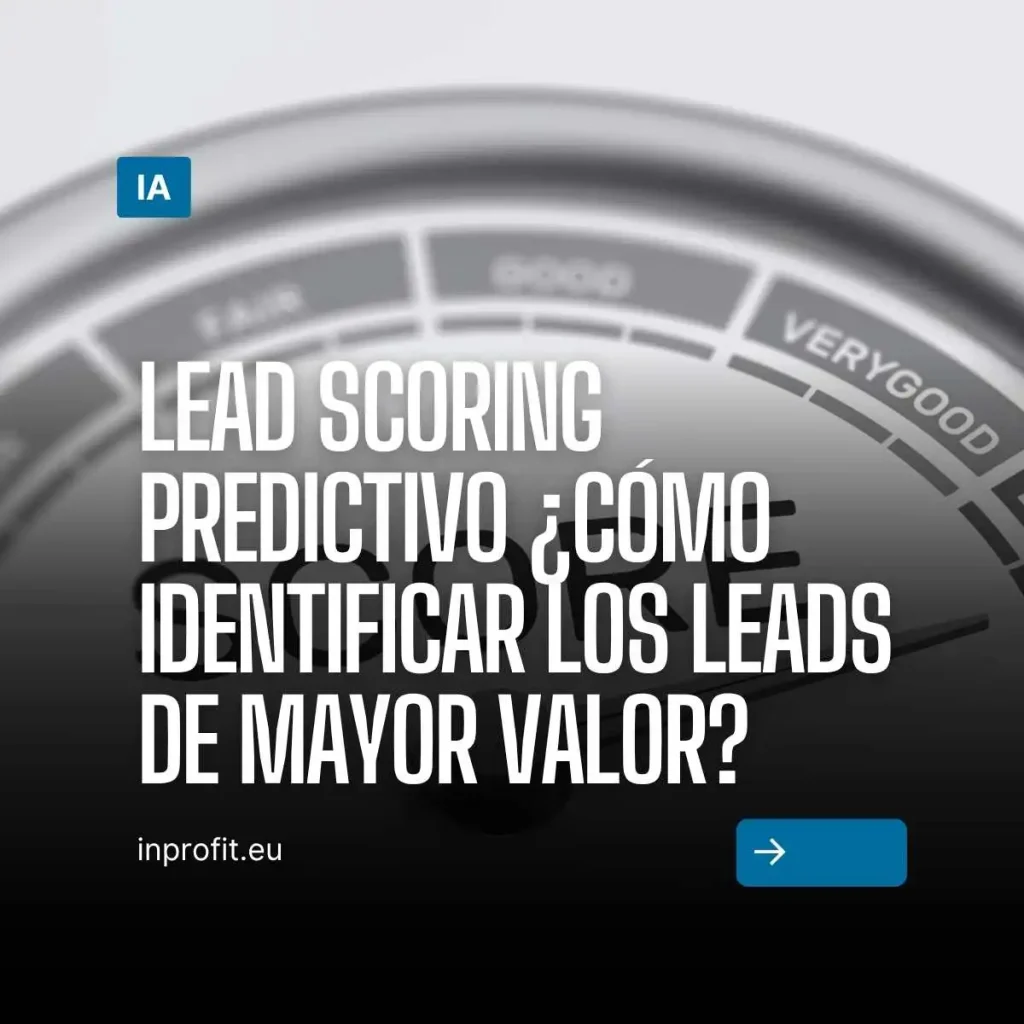What is predictive lead scoring?
Predictive lead scoring relies on machine learning models and statistical analysis to accurately estimate the probability of conversion for each prospect.
Rather than relying on static rules predefined by marketing or sales teams, this approach continuously learns from historical behavioral patterns and demographic data. Thus, as new records or interactions are added, the system automatically adjusts its predictions, providing increasingly fine-tuned ratings.
Compared to traditional methods, predictive scoring deploys constant automation that does not require manually redefining each criterion, improves accuracy by considering hundreds of variables, and reduces the impact of subjective biases.
This results in a closer alignment between marketing and sales by delivering optimized prospect lists according to their true potential.
How does predictive analytics work?
Para poner en marcha un sistema de scoring predictivo, lo primero es asegurar la recolección y preparación adecuada de los datos. Los equipos deben integrar información demográfica y firmográfica (como la industria, el tamaño y la ubicación de la empresa), datos de comportamiento (visitas al sitio web, interacciones por correo, descargas de recursos y participación en webinars) y registros transaccionales o de CRM (historial de compras y valor del cliente). Cuando sea posible, conviene enriquecer este conjunto con señales externas, como menciones en redes sociales o referencias de terceros.
The quality of these data is crucial. Before training any model, it is necessary to standardize formats, unify criteria (e.g. dates), eliminate duplicates and correct outliers that may distort predictions. Also, imputation or filling in missing data ensures that the system does not see gaps that diminish its performance.
Once this foundation has been laid, the Data Science team selects the most appropriate algorithm – from decision trees and Random Forest, which handle non-linear relationships, to logistic regression, SVM, gradient boosting such as XGBoost or even neural networks in environments with large volumes of data.
The training process is approached by dividing the set into training and validation, applying cross-validation to verify model stability and adjusting the hyperparameters to find the optimal balance between bias and variance. Finally, metrics such as AUC-ROC, precision, recall and F1-score are measured, choosing the model that offers the best performance in these indicators.
Una vez desplegado, el modelo otorga a cada lead un puntaje de conversión que puede situarse entre 0 y 100, o expresarse como un porcentaje. Con base en estos valores, se segmentan los prospectos en categorías de alta prioridad —aquellos con mayor probabilidad de conversión, listos para un contacto inmediato—, prioridad media, para los que conviene nutrirlos con más contenido, y prioridad baja, que permanecerán en flujos de marketing automatizado.
Score generation and segmentation
Once the model is trained, it is applied to new leads or to the historical base to obtain a conversion probability score, typically between 0 and 100 or between 0 % and 100 %.
- High Priority Leads (80 – 100): ready for immediate contact.
- Medium Priority (50 – 79): require additional nutrition.
- Low Priority (< 50): less urgent, they remain in automated marketing flows.
Step-by-step implementation
Before any deployment, it pays to clearly define objectives and metrics: from SQL→Opportunity conversion rate to attributable revenue. Establishing a time horizon (monthly, quarterly or annually) and setting success criteria-for example, improving a specific percentage in conversions or pipeline velocity-guides the project.
A continuación, se audita la calidad de los datos en el CRM y las plataformas de marketing, integrando las herramientas clave (como Salesforce, HubSpot, Marketo o Google Analytics) y configurando pipelines automáticos de limpieza y enriquecimiento. La decisión entre adoptar una solución SaaS —como HubSpot, Salesforce Einstein, MadKudu o Infer— o desarrollar internamente un modelo con librerías de Python dependerá del nivel técnico del equipo y del presupuesto disponible.
Deployment should be accompanied by A/B tests that compare a control group (without scoring or with traditional scoring) with another group that receives the predictive recommendations. In this way, the actual lift in conversion is measured and scoring thresholds are adjusted according to the results.
Finally, it is essential to have monitoring dashboards that show the model’s performance (AUC, CPC, CAC), to retrain it periodically – ideally every one to three months – and to feed a feedback loop with the sales team.
Step 1: Definition of objectives and metrics
- Main KPI: SQL→Opportunity conversion rate, opportunities generated, attributable revenue.
- Time horizon: will we measure performance on a monthly, quarterly or annual basis?
- Success criteria: X % improvement in conversion or reduction of the sales cycle.
Step 2: Data and systems audit
- Review data quality in CRM (Salesforce, HubSpot, Dynamics).
- Integrate platforms: marketing automation (Marketo, Pardot), Google Analytics, ERP systems.
- Set up automatic cleaning and enrichment pipelines.
Step 3: Supplier selection or in-house development
- SaaS solutions: Salesforce Predictive Lead Scoring, HubSpot Predictive Lead Scoring, Infer, MadKudu, Drift.
- In-house development: in-house Data Science team, using Python libraries (scikit-learn, TensorFlow, PyTorch).
| Supplier | Features | Technical level |
|---|---|---|
| HubSpot | Native CRM-Marketing integration, no-code interface, preconfigured dashboards. | Low – Medium |
| Salesforce Einstein | Integrated models, scale deployment, Einstein Analytics license required. | Medium-High |
| MadKudu | Specialized in B2B SaaS, advanced segmentation, granular segment scoring. | Medium |
| Infer | Data Science as a service, focus on data-driven marketing and sales, flexible API. | High |

How to use predictive lead scoring to identify high potential leads?
The first step is to delimit the ideal customer profile (ICP), establishing criteria of vertical, size and geographic area, along with value indicators such as LTV and average turnover. From there, marketing and sales should coordinate closely in periodic meetings to review the effectiveness of the scoring and adjust the MQL and SQL definitions based on real data.
When a lead exceeds the predetermined threshold, real-time alerts should be triggered to alert the SDRs to initiate contact immediately. This follow-up should be complemented by sending personalized resources – whitepapers, demos and case studies – tailored to the profile and level of interest shown.
En paralelo, la nutrición inteligente de leads se realiza mediante flujos de correo dinámico, cuyos contenidos se adaptan al puntaje del prospecto, y campañas de retargeting en redes sociales para mantener su atención. Analizar la evolución del lead score a lo largo del embudo permite detectar etapas con mayor pérdida de prospectos y optimizar tácticas o materiales en cada punto del ciclo de ventas.
Predictive lead scoring turns massive data into actionable decisions, helping organizations focus their marketing and sales efforts on those with real conversion potential.
Con un proceso que abarca desde la preparación de datos hasta el reentrenamiento periódico, esta técnica ofrece precisión, eficiencia y una mejora tangible en indicadores clave. ¡Adopta hoy mismo el scoring predictivo y acelera el crecimiento de tu funnel!



